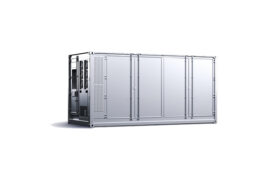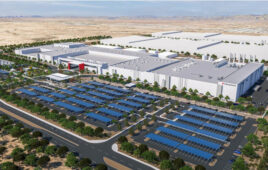Unlike battery energy storage systems (BESS), solar systems come in a wide variety of visually apparent, unique flavors: fixed-tilt ground-mount, tracker, rooftop, carport, floating and mixed-use agricultural arrays. BESS, by contrast, are predominantly grids of container boxes and step-up transformers, appearing very similar on a surface level. One would likely assume there is not much electrical difference between each BESS. However, when digging deeper, a plethora of critical subtle and hidden differences in the balance of plant electrical design are discovered that must be considered to ensure a well-integrated, high-performing and cost-effective BESS project. Listed below are 10 of the key design considerations that the Castillo Engineering team has encountered in its efforts to produce code-compliant, reliable and economically buildable BESS designs.
-
High energy density and conductors
Energy densities, particularly with the most popular lithium-ion technology batteries, are extremely high within the relatively small BESS footprint. This means that somewhere on site will have multiple, very large sets of conductors connecting items of equipment — most likely underground, usually in conduit. As a result, it is essential to determine and implement techniques that can minimize the overall cross-sectional area of the conductor to reduce installation costs while also creating a design where the necessary number of conduits can actually stub up within the designated floor access panel. This task can be especially challenging with floor access panels that appear to have been dimensioned arbitrarily small, making it difficult to fit large circles within this small square.
-
Maximum battery-string voltage and central inverters
The maximum battery-string voltage allowed by the technology is often not an economical match for large central inverter DC input voltages and requires a DC/DC converter. In these instances, it’s important to determine whether the DC/DC converter is packaged within individual containers or is a separate, large device for multiple containers. Similarly, it’s necessary to determine if the DC/AC inverters are packaged within the containers or if they are a separate, larger device for multiple containers. Depending on the number of building blocks in the system architecture, the amount of large, parallel cable runs may need doubled with the accompanying doubling and tripling of the number of cable lugs to attach and bolts to fasten.
-
Auxiliary loads
There are several factors to consider when it comes to auxiliary loads to minimize project costs. First, is the auxiliary power for cooling and heating the BESS an independent feed from the utility so the HVAC can be provided even when the utility recloser is opened? Second, it should be established whether the auxiliary power loads are clearly defined or if they appear to be an ultra-high, overly cautious value, thereby requiring costly oversized equipment. Additionally, it needs to be determined, out of that large list of auxiliary loads, which of these truly require an external circuit from the balance of plant auxiliary power panel and which ones are actually internally fed auxiliary loads that can be ignored. Battery designers often don’t differentiate between internal and external power sources, as they often lump them together under the general category of auxiliary loads.
-
Communications and cabling
One common BESS design challenge is that communications diagrams often do not indicate what sort of cabling should go between the various points. For the bidirectional power flow, it is necessary to establish the maximum full load amps in each direction based on the site-specific number of battery racks at a given operating current.
-
Determining applicable codes
When it comes to determining applicable codes, there can sometimes be conflicts or gaps between NEC Article 480, UL 1788, UL 1973, UL 9540, NFPA 101, NFPA 855, NFPA 5000, IFC Chapter 12, NFPA 1 Chapter 52, and locally adopted more restrictive requirements. It will be essential to know how many code rules change if the project involves a hybrid BESS plus solar PV installation. Finding the one-stop expert in the jurisdiction who can give a clear answer as to which codes apply will also go a long way toward ensuring the project is executed as efficiently and cost effectively as possible.
-
Cut sheets, design guides and installation manuals
BESS designs are evolving so fast that the cut sheets, design guides and installation manuals often have outdated, conflicting or missing information. Multiple RFIs and document revisions may fail to clarify things. It is a fortunate, but now rare, circumstance if the answers make pragmatic, experience-based adjudications of the information, provide numerous explanatory notes regarding design elements as required to provide clarity and don’t increase the level of confusion.
-
Gray NEC code areas
The NEC has spent much of its evolution dealing with less sophisticated, non-automated equipment that does not have on-board supercomputer-type processing capability. As a result, there are several gray code areas that the NEC does not properly address. For example, suppose the BESS has been elegantly designed with multiple fail-safe protection levels in order to prevent an overcurrent from occurring, and it has also passed exhaustive UL testing and been certified. Will the AHJ, owner’s engineer or another third-party codebook lawyer demand that a 3,000-amp external fused disconnect be installed with a 60-week lead time? The industry is probably at least two NEC code cycles away from any language on this gray area.
-
Lack of clarity regarding terminology
As a result of rapid BESS growth and continual technological innovations, there is still a great deal of confusion, misunderstanding and lack of agreement about specific terminology. Here are some recent examples from projects Castillo Engineering worked on:
“We don’t consider that a battery, that’s just a cell.”
“We don’t connect those cables to the battery rack. We need to connect them at the end of the string of interconnected battery racks.”
“That container over there just has batteries in it and only needs DC power output cables connected to it, while the identical looking container right next to it contains an inverter and only half the number of battery racks, so it gets AC power conductors. Was there a reason that they placed the one with the AC power output conductors the furthest from the step-up transformer and utility point of interconnection?”
-
Increase in underground conduits and standpipes
There are going to be a lot of large electrical conduits underground with BESS, but these conduits are also starting to have some non-electrical company. Many containers come equipped with a standpipe at either end so firefighters can attach a hose and flood the compartment with water, should that be required. Depending on the intensity of the fire, there probably won’t be many volunteers to step up and attach that hose, so BESS installation manuals are starting to recommend that the standpipe connections be made at some distance from the container. Therefore, not only has the number of large underground pipes drastically increased, but water pipes are running under and over electrical ducts.
-
Lack of terminals
Assuming one is installing a BESS product with excellent documentation and well labeled terminations, there are still issues that may present themselves in later stages. Don’t be surprised if the lead electrician is ready to terminate the main BESS ground in the master controller, and it appears that no terminals have been provided for it.







Tell Us What You Think!